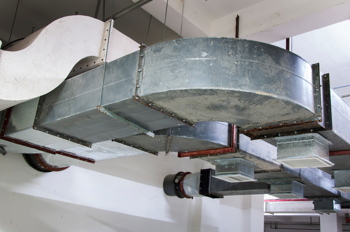Ductwork cleaning — defining responsibilities

Malcolm Moss of ADCAS highlights some of the most common questions asked about the provision of cleaning arrangements in ductwork projects and contracts, and outlines the latest guidance on these topics.
Ductwork cleanliness is a hot topic in the industry thanks to heightened awareness about the potential for ductwork to act as a vehicle for the spread of disease and infections, not to mention its potential impact on the energy use of ventilation systems.
Two key documents inform the best practice approach contractors should be adopting. These are ‘DW/144 Second Edition (Specification for sheet metal ductwork — low, medium and high-pressure/velocity air systems)’; and ‘TR/19 (Internal cleanliness of ventilation systems)’.
These publications provide guidance on the key issues surrounding ductwork cleanliness in terms of who is responsible for providing access, and where the responsibilities for cleaning are split between installer and specialist cleaner. The legislation makes for weighty reading, and in order to help busy contractors get to the heart of the matter, ADCAS has put together its own document ‘The ADCAS guide to ductwork cleaning and requirements and access doors’.
This document is available free from the ADCAS website (see link below) and includes a comprehensive Q&A section. Some of the main questions and answers are listed here, but reading of the full ADCAS Guide is highly recommended for installers and customers alike.
1. How does a ductwork contractor or cleaning contractor know where to fit access doors?
This is an issue you must always discuss and agree with your client. Tables are provided in both TR/19 (table 3, page 13) and DW/144 (Table 20, page 92) to help inform those discussions. These tables also set out who is responsible for which access doors — the installer or the specialist cleaning contractor.
2. What if a ductwork contractor has installed access doors as prescribed by the guidance, but the client then requests additional doors for cleaning purposes?
This is where it is useful to lean on DW/144 in client discussions, which states that additional panels may be required for cleaning inspection and cleaning access and that they will be site-fitted where necessary by a specialist cleaning contractor.
3. If a client wants the contractor to fit the cleaning access panels and clean the ductwork, how can he be persuaded otherwise?
Again, if this matter arises, you should point him in the direction of DW/144, and in particular clause H.2.3, which lists seven reasons why a specialist cleaning contractor should be employed.
4. How can you avoid, post installation, some of the access doors becoming inaccessible owing to other services blocking them or other building constraints.

TR/19 says: ‘It is for the designer and the other project parties responsible for the implementation of the design under CDM “cascade” principles, to ensure that access panels are not obstructed by pipework, cable trays or any other obstacle during the building process.’ If time is taken to get the process right at design stage and good use is made of tools like Building Information Modelling, common problems like this can be avoided.
5. What is the right course of action if a client is now asking for bigger access panels than those installed as he says that he cannot get into the duct?
If all project specifications have been met, DW144 is your best friend in this scenario. Section 20.2 states: ‘The opening will be sized to provide hand and/or arm access only, and the system designer shall specify the size and location of panels where larger openings are required.’
6. We have installed a ductwork system very carefully and exactly to Intermediate PDI as defined in Table F.2 in TR/19. It has, however, failed the acceptable dust accumulation levels as defined in Table F.1 of TR/19. How can this happen and who should now clean it?
The only way to guarantee that dust accumulation levels will be met is to plan for a post installation clean. Use the pre-contract checklist in the ADCAS guide to determine each party’s responsibilities. Be very wary of contracts that say something along the lines of ‘it will be the ductworkers’ responsibility to clean the ductwork if upon testing it fails to meet acceptable dust accumulation levels’.
7. What is the right course of action if there is no design information to ensure that the ductwork supports are able to support manned access?
First, check and understand your design liabilities on the project. It is very common for the ductwork contractor to be expected to hold this responsibility. Where the responsibility rests with others, refer it back to the design team. It is their responsibility to take into consideration the loading on ductwork supports where the ductwork is likely to be internally accessed by a man when cleaning. Refer also to BS EN 12236 for more information.
8. The specification requires the ductwork to be installed to Advanced PDI with a specialist after-clean. It seems a waste of time, money and resources to factory seal/protect during transport/site clean/ cap off on site when it is to be cleaned afterwards.
ADCAS agrees. Refer to TR/19, Table F2, Note 2 that states, ‘Since the ductwork will be cleaned post-installation, many costly and onerous procedures such as capping during transport can be dispensed for most installations.’ It is important that at pre-contract this issue is clarified.
Malcolm Moss is President of the Association of Ductwork Contractors & Allied Services (ADCAS) and managing director of Doby Verrolec.








